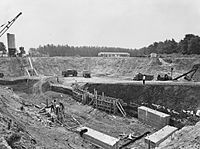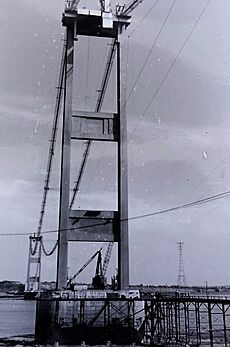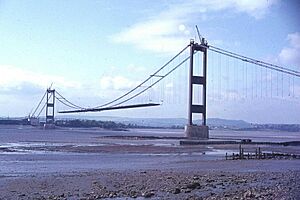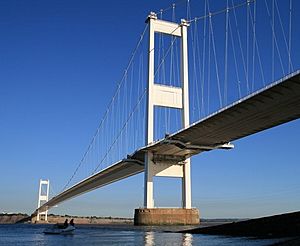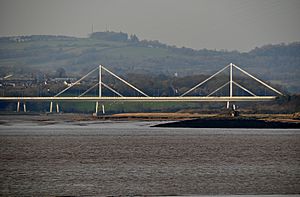Severn Bridge facts for kids
Quick facts for kids Severn Bridge |
|
|---|---|

The Severn Bridge seen from Aust Beach, England
|
|
| Coordinates | 51°36′33″N 02°38′18″W / 51.60917°N 2.63833°W |
| Carries | |
| Crosses | River Severn River Wye |
| Locale | South West England / South East Wales |
| Maintained by | National Highways |
| Heritage status | Grade I listed |
| Characteristics | |
| Design | Suspension bridge |
| Total length | 0.99 mi (1.6 km) |
| Height | 445 ft (136 m) |
| Longest span | 3,240 ft (988 m) |
| Clearance below | 154 ft (47 m) |
| History | |
| Architect | Freeman Fox and Partners in association with Mott, Hay and Anderson, consulting architect Sir Percy Thomas |
| Constructed by | John Howard & Co., Sir William Arrol & Co., Cleveland Bridge & Engineering Company and Dorman Long |
| Opened | 8 September 1966 |
| Statistics | |
| Daily traffic | Between 17,155 and 17,828 (2003–2008) |
| Toll | Free |
The Severn Bridge (Welsh: Pont Hafren) is a large suspension bridge that connects South Gloucestershire in England with Monmouthshire in South East Wales. It crosses the River Severn and the River Wye. This bridge was the first major road link between England and Wales across the Severn Estuary.
Building the bridge took three and a half years and cost about £8 million. It replaced an old ferry service that had been running for 137 years. Queen Elizabeth II officially opened the bridge in 1966. For 30 years, it was part of the M4 motorway. In 1999, it was given a special "Grade I listed" status, meaning it's a very important historical structure.
After a newer bridge, the Second Severn Crossing, was built, the Severn Bridge became part of the M48 motorway. Besides carrying cars, the bridge also has special paths on each side for people to walk or cycle. These paths are part of the National Cycle Route 4 and EuroVelo cycle routes.
Contents
History of the Severn Bridge
The idea for a bridge across the River Severn is very old. The first suggestion came in 1824 from Thomas Telford, a famous engineer. He was asked to find ways to make mail coach services better between London and Wales. However, nothing happened with his idea at that time.
In the early 1900s, as more cars appeared, people again wanted a bridge. Local councils tried to get permission to build it in 1935, but Parliament said no. This was because the Great Western Railway Company was worried about competition.
After the Second World War, plans for a national road network began. The government decided to build the Severn Bridge. Construction started in 1961. The government decided that drivers would pay a small fee, called a toll, to cross the bridge. However, walking or cycling across was always free.
The main structure of the bridge was finished in 1963. The large parts of the bridge were put together between 1963 and 1966.
Bridge Maintenance and Upgrades
In 1977, engineers found some weaknesses in the bridge. Traffic was limited to one lane in each direction for several months while repairs were made.
The bridge was strengthened and resurfaced in the late 1980s because more and more traffic was using it. This work included making the towers and the bridge deck stronger. The original single cables that held the bridge were replaced with two cables. These new cables have an open design that makes them easier to maintain.
In 2006, the bridge was checked for rust on its suspension cables. The inspection showed that heavy trucks needed to be restricted to one lane. To stop the rust, a system of rubber casing and dry air circulation was added to the cables between 2007 and 2009.
In May 2025, most heavy goods vehicles (over 7.5 tonnes) were banned from the bridge for a trial period. This was because tests on corroded cable strands showed they were weaker than expected. National Highways is working on a solution to allow these vehicles back safely.
Building the Severn Bridge
Construction of the Severn Bridge began in May 1961. The main parts of the bridge started to be built 12 months later. Special equipment, some of which had been used on the Forth Road Bridge in Scotland, was brought to the site.
The bridge's safety railings and steel barriers were made by a company called Bayliss Jones & Bayliss. They also made similar parts for other major bridges.
Zinc wire was used to protect the steel parts of the bridge from rust. In November 1962, a large order for 4,200 tons of strong steel wire was placed. The first cables were built in late October 1963. By January 1964, a walkway was set up across the towers.
The main work of building the huge cables across the Severn began in mid-February 1964. These cables were so important that they were even lit up at night in March 1964. The Minister of Transport, Ernest Marples, walked across the cable structure in June 1964. The cables were fully completed on July 9, 1964, taking only four months with 50 workers.
The large road sections, each weighing 130 tons, were lifted into place using special barges. This was the first time bridge sections had been floated on the river and then lifted. There were 88 road sections in total. The very last section was put into place on July 19, 1965.
Parts of the Severn Crossing
The Severn Bridge crossing is actually made up of four main structures. From England to Wales, these are: the Aust Viaduct, the Severn Bridge, the Beachley Viaduct, and the Wye Bridge. In 1998, the Severn Bridge and Aust Viaduct were given Grade I listed status. The Beachley Viaduct and Wye Bridge received Grade II listed status.
Aust Viaduct
The Aust Viaduct is about 514 feet (157 meters) long. It's a strong structure that carries the road from the top of Aust Cliff to the main part of the Severn Bridge.
Severn Bridge (Main Section)
The main Severn Bridge is a suspension bridge. This means its deck is held up by two huge main cables that hang between two tall steel towers. In 1966, the cables were made from 18,000 miles (29,000 km) of wire! Each main cable has 8,322 individual wires.
An interesting fact is that the cables supporting the bridge deck are not straight up and down. They are arranged in a zig-zag pattern. This helps to reduce shaking and vibrations. The bridge is 5,240 feet (1,600 meters) long. The central part between the towers is 3,240 feet (988 meters) long. The towers themselves rise 445 feet (136 meters) above the water.
The bridge deck is shaped like an airplane wing. This special shape helps the bridge stand strong against the wind. The sections of the deck were built in Chepstow. Each 132-tonne section was floated down the river and then lifted into place.
Beachley Viaduct
The Beachley Viaduct is 2,444 feet (745 meters) long. It's built similarly to the Severn Bridge deck but rests on steel supports. It crosses over the Beachley peninsula, where the British Army camp, Beachley Barracks, is located.
Wye Bridge
The Wye Bridge (Welsh: Pont Gwy) is a cable-stayed bridge that is 1,340 feet (408 meters) long. It crosses the River Wye, which marks the border between England and Wales. This bridge has a single large section held up by cables from two tall pylons. The deck is similar to the Severn Bridge but looks different because it has two sets of cables on each tower. The Wye Bridge was built by Cleveland Bridge & Engineering Company.
Tolls and Bridge Ownership
A toll is a fee paid to use a road or bridge. For many years, drivers had to pay a toll to cross the Severn Bridge. The toll was collected only on the English side, for vehicles traveling from England to Wales. Some people jokingly called it a "tax on entering Wales."
The Welsh poet Harri Webb even wrote a short poem about it:
Two lands at last connected
Across the waters wide
And all the tolls collected
On the English side
Over the years, the toll amount changed. However, a big change happened in 2018. The tolls on the Severn crossings were completely removed on December 17, 2018. This meant that for the first time since the bridge was built, it was free to cross into Wales.
Who Owned the Bridge?
For a period, the ownership and operation of the bridge were managed by a private company called Severn River Crossing plc. This was part of a deal to build the newer Second Severn Crossing.
However, on January 8, 2018, ownership of both the Severn Bridge and the Second Severn Crossing returned to the UK government. This happened because the company had collected enough money from tolls to cover the costs of building and maintaining the bridges, as agreed.
Bridge Status and Closures
Sometimes, the Severn bridges have to close. For example, on February 6, 2009, and again on December 22, 2009, both Severn bridges were closed at the same time. This was because ice was falling from the bridge structures, which could damage vehicles.
There are ways to check if the bridges are open. A special app called Enviroute provides updates on the status of both bridges.
Images for kids
See also
 In Spanish: Puente del Severn para niños
In Spanish: Puente del Severn para niños
- List of crossings of the River Severn
- List of crossings of the River Wye
- List of international bridges
- Aust Severn Powerline Crossing


